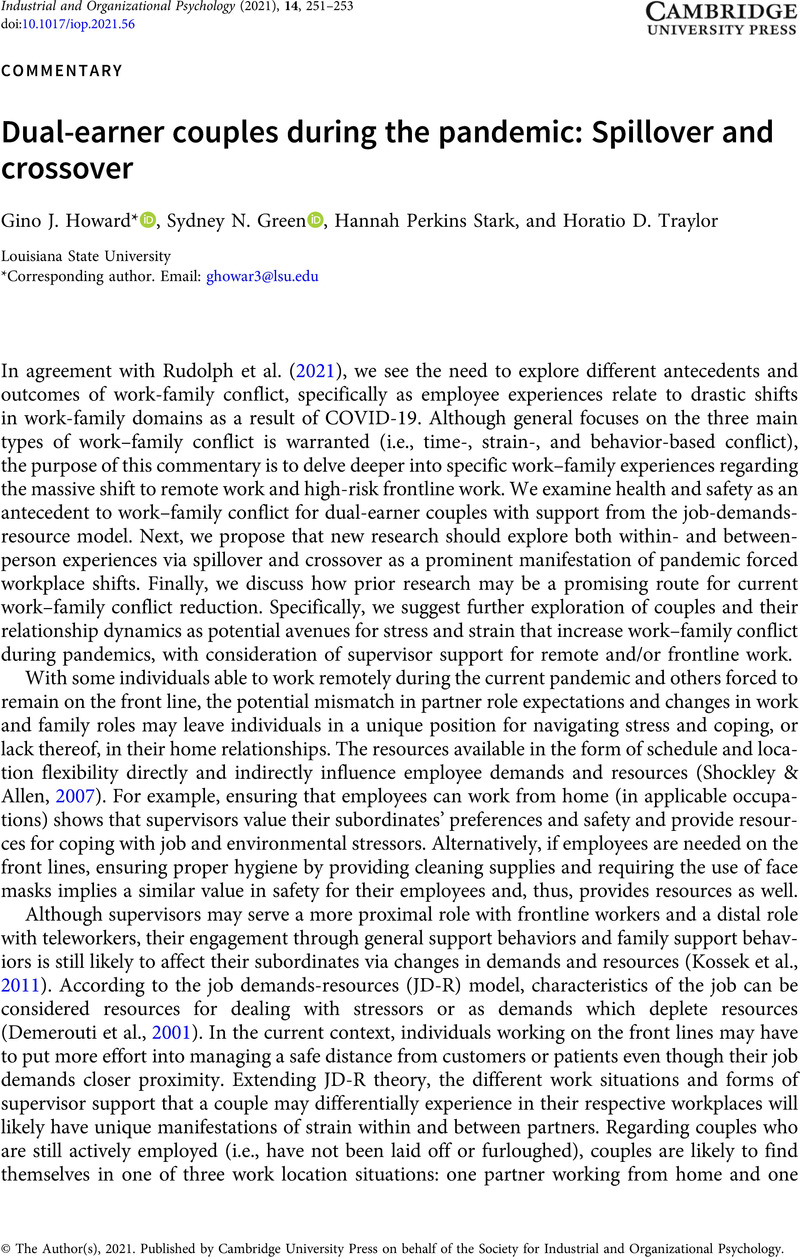No CrossRef data available.
Article contents
Dual-earner couples during the pandemic: Spillover and crossover
Published online by Cambridge University Press: 24 May 2021
Abstract
An abstract is not available for this content so a preview has been provided. Please use the Get access link above for information on how to access this content.

- Type
- Commentaries
- Information
- Industrial and Organizational Psychology , Volume 14 , Special Issue 1-2: Special Pandemic Issue , June 2021 , pp. 251 - 253
- Copyright
- © The Author(s), 2021. Published by Cambridge University Press on behalf of the Society for Industrial and Organizational Psychology.
References
Bakker, A. B., & Demerouti, E. (2013). The spillover-crossover model. In Grzywacz, J. G. & Demerouti, E. (Eds.), New frontiers in work and family research (pp. 55–70). Psychology Press.Google Scholar
Berkowsky, R. W. (2013). When you just cannot get away: Exploring the use of information and communication technologies in facilitating negative work/home spillover. Information, Communication & Society, 16(4), 519–541. doi: 10.1080/1369118X.2013.772650
CrossRefGoogle Scholar
Demerouti, E., Bakker, A. B., Nachreiner, F., & Schaufeli, W. B. (2001). The job demands-resources model of burnout. Journal of Applied Psychology, 86(3), 499–512. doi: 10.1037/0021-9010.86.3.499
CrossRefGoogle ScholarPubMed
French, K. A., Dumani, S., Allen, T. D., & Shockley, K. M. (2018). A meta-analysis of work–family conflict and social support. Psychological Bulletin, 144(3), 284–314. https://doi-org.libezp.lib.lsu.edu/10.1037/bul0000120.supp
CrossRefGoogle ScholarPubMed
Hammer, L. B., Kossek, E. E., Anger, W. K., Bodner, T., & Zimmerman, K. L. (2011). Clarifying work–family intervention processes: The roles of work–family conflict and family-supportive supervisor behaviors. Journal of Applied Psychology, 96(1), 134–150.CrossRefGoogle ScholarPubMed
Higgins, C., Duxbury, L., & Julien, M. (2014). The relationship between work arrangements and work–family conflict. Work: Journal of Prevention, Assessment & Rehabilitation, 48(1), 69–81. doi: 10.3233/WOR-141859
CrossRefGoogle ScholarPubMed
Hill, E. J., Yang, C., Hawkins, A. J., & Ferris, M. (2004). A cross-cultural test of the work–family interface in 48 countries. Journal of Marriage and Family, 66(5), 1300–1316. doi: 10.1111/j.0022-2445.2004.00094.x
CrossRefGoogle Scholar
Kossek, E. E., Pichler, S., Bodner, T., & Hammer, L. B. (2011). Workplace social support and work–family conflict: A meta-analysis clarifying the influence of general and work–family-specific supervisor and organizational support. Personnel Psychology, 64(2), 289–313. doi: 10.1111/j.1744-6570.2011.01211.x
CrossRefGoogle ScholarPubMed
Rudolph, C.W., Allan, B., Clark, M., Hertel, G., Hirschi, A., Kunze, F., Shockley, K., Shoss, M., Sonnentag, S., & Zacher, H. (2021). Pandemics: Implications for research and practice in industrial and organizational psychology. Industrial and Organizational Psychology: Perspectives on Science and Practice, 14(1), 1–35.Google Scholar
Shockley, K. M., & Allen, T. D. (2007). When flexibility helps: Another look at the availability of flexible work arrangements and work–family conflict. Journal of Vocational Behavior, 71(3), 479–493. doi: 10.1016/j.jvb.2007.08.006
CrossRefGoogle Scholar
Stevens, D. P., Kiger, G., & Riley, P. J. (2006). His, hers, or ours? Work-to-family spillover, crossover, and family cohesion. Social Science Journal, 43(3), 425–436. doi: 10.1016/j.soscij.2006.04.011
Google Scholar




